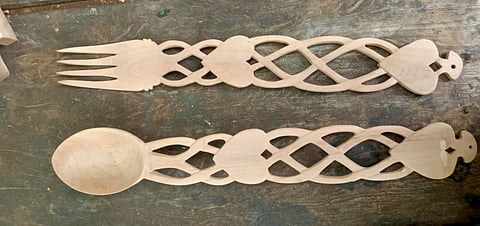
- Destinations
- Experiences
- Stay
- What's new
- Celebrating People
- Responsible Tourism
- CampaignsCampaigns
- SubscribeSubscribe
- Buy Now

The more than 200-year-old craft of Udayagiri (a town in the Sri Potti Sriramulu Nellore district of Andhra Pradesh) - wooden cutlery - is shining bright as a beacon in this age when the need for environment-friendly, biodegradable, locally made, and sourced items used in the food industry has increased manifold. With the Geographical Identification (GI) tag, which was applied for jointly by The Andhra Pradesh Technology Development and Promotion Centre and Andhra Pradesh Handicrafts Development Corporation, Udayagiri wooden cutlery has received a significant value addition.
This labour-intensive craft is said to have originated in Udayagiri during the rule of the Nawabs of Arcot, and the jagirdar, or landowner, Mustafa Ali Khan. He was granted the jagir, or ownership of the region, by the Nawabs of Arcot. Khan and his descendants reigned over the area till 1839. Over the years, the royals and jagirdars patronised the Udayagiri artisans, and the craft reached great heights. The arrival of the British East India Company, however, pushed the Udayagiri craft almost to extinction. In present times, the craft is going through a revival phase.
Traditionally, the craft was male-dominated. However, now, women are at the forefront. The most prominent and awarded names are that of Shaikh Ghousia Begum, a generational artisan, and she has trained several women to carry forward the art of wood carving. Ghousia Begum was awarded the Dr. YSR Achievement Award 2021. Her son Zaheer Sheikh took up the reins and kept the craft alive. Additionally, some artisans have come together to set up the Udayagiri Cutlery Mutual Aided Cooperative Society.
The range of handmade wooden cutlery consists of forks, spoons, knives, scoopers, spatulas, ladles, bowls, and plates of all sizes. Each item is carved with Persian-style motifs, such as the amini, khajuri, kangura and the beautiful dargah ki jaali. The wood is sourced from the Durgampalli hills, and nardi, devadari, bikki, kaldi, or palabarki tree wood is used for the cutlery. The softest wood, nardi, is only used for decorative items, while the hard kaldi wood is used for making items of daily use.
Once the wood is acquired, the logs are stored for around ten days to be de-moisturised. They are soaked in water and put out to dry again before carefully cutting them into smaller blocks, making them easier to carve. The next step is to wrap up the blocks with jute rope and compress them with a heavy stone slab. This technique renders the wood fibres soft and the block more suited to being carved. The basic shape of the cutlery is marked on the block, and carved with the chisel, or the gor uli. This requires focus and a steady hand as the wood has turned quite soft, and one wrong scoop can ruin the design. The other tools which are used to shape, file, and carve the intricate patterns on the stem of the cutlery are file, or gol kaadi, and the paper finishing machine, which is used for the large cutlery.
About 400 families in Udayagiri practice this craft. However, according to many of the craftspeople, they need better support from the authorities. To cater to demands for modern tastes, they are also making bowls, coasters, platters, and ornamental accessories keeping the design element intact.
Getting There: Udayagiri is a little less than 100km by road from Nellore city, which is the most convenient transport hub. The nearest airports to Nellore are Tirupati (120km by road) and Chennai (190km by road). Nellore is also well connected by road and rail with the rest of the country.
